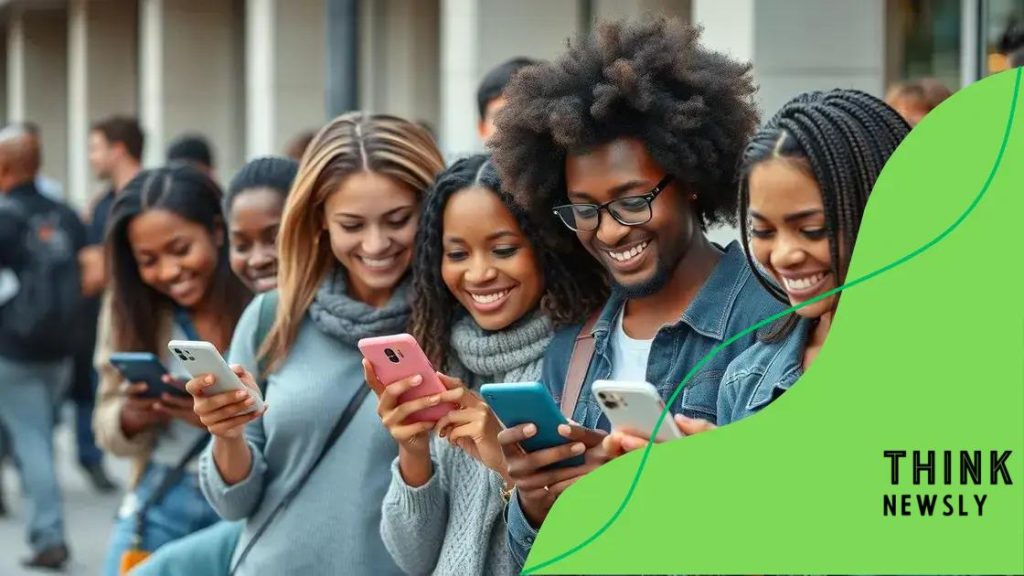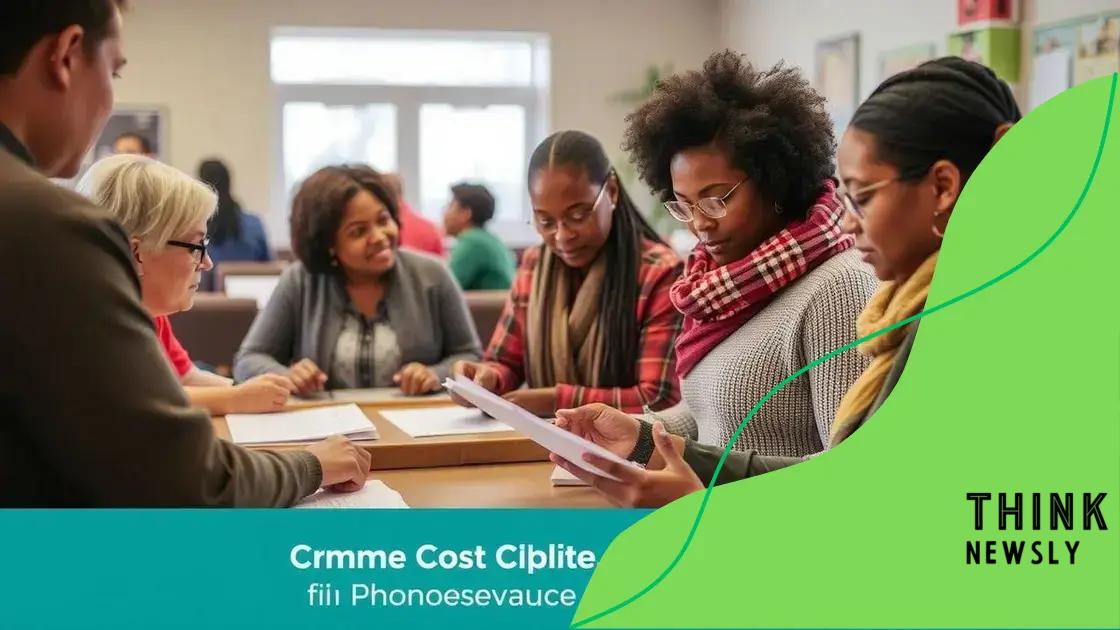Free phone service expands to low-income groups

Anúncios
Free phone service expands to low-income groups, providing them essential tools for communication, education, and access to health resources, significantly improving their quality of life and opportunities for success.
Free phone service expands to low-income groups, creating significant opportunities for those who need them most. Have you ever thought about how a simple phone connection can change lives? In this article, we’ll dive into the implications of this service and why it matters now more than ever.
Anúncios
Understanding the need for phone service access
Understanding the need for phone service access is crucial in today’s world. Many people rely on their phones for daily activities, whether it’s for communication, accessing the internet, or emergency services. For low-income groups, having access to a phone can be a gateway to various opportunities.
Why Access Matters
Access to phone services is not just about making calls. It can significantly impact education, job hunting, and healthcare access. For instance, students use phones for online learning, while job seekers depend on them for applying to jobs and communicating with prospective employers.
Key Benefits of Phone Service Access
- Improved communication: Staying connected with family and friends helps strengthen support networks.
- Increased job opportunities: Many employers communicate through phones for interviews and updates.
- Emergency assistance: Having a phone allows individuals to call for help or support during emergencies.
Moreover, phone access enables low-income individuals to access essential services. With the rise of telehealth, people can consult with healthcare professionals without needing to travel. This is especially vital for those with mobility issues or those living in remote areas.
Anúncios
Community programs are increasingly recognizing this need. They are providing free or subsidized phone services to ensure that everyone can be connected. The initiative not only bridges the gap between low-income groups and vital services but also fosters inclusivity.
Ultimately, addressing the need for phone service access is about empowering individuals and communities. When people are connected, they can thrive, explore opportunities, and access the resources they need to live healthier, more fulfilling lives.
How free phone service works
Understanding how free phone service works is essential for those who can benefit from it. Different programs offer various types of services, making phone access easier for low-income users. These services typically rely on connectivity through established networks and are funded by government initiatives or nonprofit organizations.
Types of Free Phone Services
There are generally two main types of free phone services: prepaid plans and subsidized programs. Prepaid plans allow users to get a phone with free minutes, often through a simple application process. Subsidized programs, on the other hand, provide phones at no cost to eligible families.
How to Qualify for Free Service
- Income-based criteria: Many programs require applicants to show that their income is at or below a certain level.
- Participation in government assistance: Being enrolled in programs like SNAP or Medicaid may also qualify you for free phone services.
- State-specific regulations: Some states have different rules or additional programs, so it’s vital to check local options.
Once a person qualifies, they can often choose from various plans tailored to their needs. These plans may include unlimited texts, limited data, or free voice calls to specific numbers. The aim is to provide users with tools to stay connected without putting a financial strain on their budgets.
Free phone service programs work with major carriers that ensure a reliable connection. These services can offer the same quality coverage as paid plans, allowing users to connect with family, access healthcare, and seek educational resources with ease. Understanding these aspects can help individuals make informed decisions when choosing a plan that works best for them.
Eligibility criteria for low-income groups

The eligibility criteria for low-income groups concerning free phone services is designed to ensure that those who need assistance the most can receive it. Generally, applicants need to prove their financial status, showing that their income falls below a certain threshold.
Common Requirements
Most programs require specific documentation to verify income and residence. Applicants may need to provide proof such as:
- Pay stubs: Recent pay stubs can help demonstrate your current income level.
- Tax returns: Copies of the previous year’s tax return may also be requested.
- Benefit letters: Letters proving enrollment in assistance programs like SNAP, Medicaid, or SSI can ease the application process.
In addition to income verification, some programs also consider household size. A larger family typically has higher income limits for eligibility. Each program might define these limits differently, so it’s crucial to check specific guidelines.
Moreover, most programs focus on providing services to individuals who are not only low-income but also need to stay connected for essential reasons. This includes those seeking employment, attending school, or managing health care. Bridging the communication gap for these individuals is at the heart of these initiatives. Understanding these requirements can make the application process smoother, allowing eligible individuals to access the support they need efficiently.
Benefits of expanded connectivity
The benefits of expanded connectivity are numerous and far-reaching, particularly for low-income groups who gain access to free phone services. This increased connectivity can drastically change lives by providing essential tools for communication, education, and access to services.
Improved Access to Information
With phones, individuals can easily access crucial information. Whether it’s looking for jobs, learning new skills, or finding health resources, connectivity provides a pathway. This access can be the difference between staying informed and feeling isolated.
Enhanced Communication
- Staying connected with family: Having a phone allows individuals to maintain relationships, which is important for emotional support.
- Networking opportunities: Free phone services help users connect with potential employers and community resources.
- Emergency support: Quick access to emergency services can save lives, offering peace of mind for individuals and families.
Moreover, expanded connectivity encourages participation in community and social activities. Connected individuals are more likely to engage in local events, volunteer, and seek community-based programs. This involvement not only enriches their lives but also strengthens community bonds.
Furthermore, access to social media and online communities helps individuals stay engaged. Whether through education platforms or social support groups, users can connect with others who share similar experiences or challenges. This sense of belonging can alleviate feelings of isolation, especially in marginalized communities.
Ultimately, the benefits of expanded connectivity go beyond just communication; they empower individuals to improve their lives, participate in society, and access crucial services that foster personal and community growth. The ripple effect of being connected can lead to more informed, engaged, and resilient individuals.
Real-life success stories
Real-life success stories illustrate the powerful impact of free phone services on individuals and communities. These stories highlight how access to effective communication can change lives and open doors to new opportunities.
Empowering Job Seekers
For many, having a mobile phone is crucial in the job market. Take the story of Maria, a single mother who struggled to find stable employment. With the assistance of a local program offering free phone services, Maria received a smartphone. This tool allowed her to apply for jobs online, attend virtual interviews, and stay connected with potential employers. Within months, she secured a job that improved her family’s financial situation significantly.
Enhancing Education
- Access to online resources: Students from low-income families rely on phones to access educational materials. For instance, John, a high school student, used his phone to download study resources, which improved his grades.
- Facilitating remote learning: During the pandemic, many students shifted to online learning. With free phone access, students like Sarah could attend virtual classes and complete assignments, maintaining their education despite challenges.
- Building connections: Educators have reported that students who are connected are more likely to participate and engage in their learning.
Additionally, individuals have shared stories about how having a phone helped them access healthcare services. David, who has diabetes, found it hard to keep track of his appointments without a mobile device. After receiving a free phone, he could schedule appointments with his doctor and manage his health more effectively. This access to medical care was life-changing for him, as it led to better health outcomes.
These success stories demonstrate the importance of providing free phone services. They empower users, enabling them to improve their lives and communities. As more individuals gain access to communication tools, the chances for success multiply, showcasing the transformative power of connectivity.
FAQ – Frequently Asked Questions About Free Phone Services for Low-Income Groups
Who is eligible for free phone services?
Eligibility typically includes low-income individuals who meet specific income criteria or participate in government assistance programs like SNAP or Medicaid.
What types of services are offered?
Free phone services often include prepaid plans with free minutes, unlimited texts, and low-cost data options designed for easy communication and access to information.
How can free phone services improve access to education?
Free phone services enable students to attend online classes, access educational resources, and stay connected with teachers, enhancing their learning experience.
What are some success stories of individuals benefiting from these services?
Many individuals have found employment, improved their health care access, and enhanced their education through free phone services, transforming their lives for the better.





